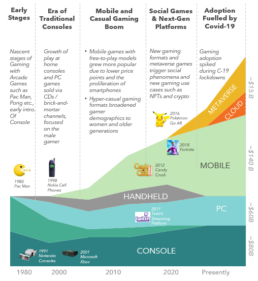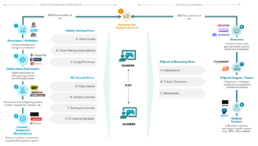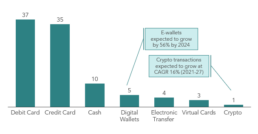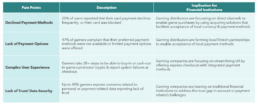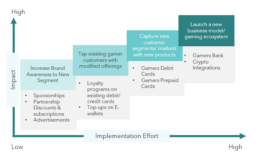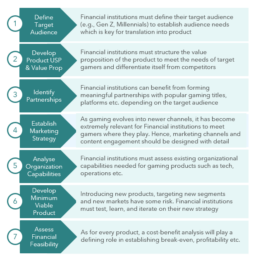Time To Get Your Game On!
The gaming industry is a ~$300 Billion (1) giant, with a third of the world’s population playing games. The industry has now surpassed the movie and music industry combined. Highest grossing games titles such as the Call of Duty Franchise and Grand Theft Auto V are recording higher sales than big blockbuster hits. Gaming has evolved over time, coming a long way from its traditional arcade days, to grow into a social phenomenon. Several innovations have contributed to its adoption. From the classic arcade games such as Pac Man and Pong, to the original consoles such as the Odyssey and Nintendo 64, and to PC games, this industry had traditionally catered to the stereotypical middle-aged male gamer. However, the proliferation of smart phones and mobile games gave rise to casual and free-to-play (F2P) gaming formats that catered to broader demographics. Access to faster and more reliable internet sparked the shift to digital-first gaming formats and cemented mobile games as the preferred channel. Next-generation gaming titles, channels, and platforms in the Metaverse (e.g., Axie Infinity) are still in nascent stages, but are expected to redefine gaming once again.
Mobile gaming is giving rise to newer formats including social gaming, play-to-earn, metaverse & cloud gaming. An increasing number of people now participate in e-sports as players or viewers.
Platforms such as Twitch, Discord, Steam etc. along with the creator economy have given rise to gaming communities which has further increased popularity of social gaming. Gamers are spending more time than ever on these platforms playing, viewing, trading, and socializing with their peers. Some of the most popular streamers have accumulated 20M viewership hours and 18M followers.(2)
Exhibit 1. Evolution of Gaming
Era of Record Growth
The steep growth of gaming has been fueled by several factors:
- Pandemic: The pandemic brought gaming to a tipping point due to increased digitization & need for social interaction
- Smartphone & Internet Proliferation: Consumers now have more gamer-friendly phones with better access to faster internet services such as 5G
- Social Games: Gamers now have access to better games & formats that before. Rise of social & hyper gaming formats have led to expansion in demographic appeal
- Digital Distribution: Games are not distributed online increasing ease of access to different gaming formats
- Acceptance of Local Payment Methods: Most gaming platforms are now diversifying their acceptance solutions to include APMs and local payment methods such as wallets, prepaid cards etc.
- Creator Economy: There is a rise in live streaming & e-sports viewership due to the increase in influencer/ creator led marketing
The gaming industry now presents a largely untapped opportunity for
Financial Institutions. As gaming diversifies from traditional channels such as mobile, PC & Console into cloud gaming,
Augmented Reality & Metaverse, the opportunities to monetize on sizeable payment flows by targeting a new younger customer segment increase significantly. There are successful examples from around the globe for gaming-related payment products not limited to but including cards, credit solutions, alternative payment methods etc. designed especially for gamers.
Exhibit 2. Global Gaming Revenue (in US$ B)
Designed for Everyone
The number of gamers worldwide is expected to reach ~3.8 billion by 2028. While gaming is the most popular leisure activity for Gen Z and Millennials, an increasing number of Gen X and Baby Boomers are taking up gaming making the gaming audience extremely diverse.
Different generations have different motivators for playing games, for example, Gen Z plays to compete & develop skills while Gen X plays to unwind. The motivators also translate into different spending habits, time spent and subsequently different opportunities for each generation of gamers. With the popularity of newer gaming channels such as mobile and metaverse-related games, gaming companies are increasingly experimenting with newer types and genres including strategy, puzzles, sports, shooter, survival, rhythm, musical etc. to target new segments. These newer models also cater to the female demographic, with ~48% of gamers identifying as female in 2022. Moreover, gamers are spending more time in gaming platforms then ever. Individuals now also play to stay connected with their friends and family while enjoying their leisure time.
Exhibit 3. Regional Gaming Revenue
Exhibit 4. Gamers by Generation (3)
Hence, online multiplayer games offering immersive experiences are gaining popularity among gamers of all age groups. Each generation of gamers has some attributable traits:
1.Gen Z: Comprising the highest share of hardcore gamers, Gen Z spend the highest time gaming split mostly equally across Mobile, Console & PC. They show the most interest in Metaverse, which is expected to define the future of gaming, due to an underlying interest in social activities such as getting together with friends & hosting events.
Most popular games enjoyed by Gen Z includes Battle Royale, Sandbox & other multiplayer online battle arena games & non-crypto metaverse such as Roblox & Fortnite.
2.Millennials: As most millennials are social gamers with limited prevalence of hardcore gamers, they spend a considerable amount of time gaming across Mobile, Console & PC. They have strong preference for role-playing, strategy & adventure gamers.
3.Gen X: Most Gen X consumers are casual gamers and prefer playing gamers on mobile platforms, followed by PC and lastly console. They are casual players who like to play puzzle, shooter or sports gaming genres.
The Next Big Thing In Gaming- The Metaverse
The global metaverse market is expected to reach US$ 430 billion in 2027, growing at a CAGR of 47.6%(4). This growth significantly contributes to the increase in uptake of online video gaming as a direct consequence of Augmented Reality/ Virtual Reality technologies. While Metaverse has many use cases including social interactions, entertainment, social commerce etc., gaming remains the most lucrative use case that is being adopted by millions of users worldwide as a gateway to the Metaverse. The virtual gaming world has been backed by blockchain technologies including multiplayer & interactive games.
The introduction and rise of cryptocurrencies have enabled a change in the gaming paradigm. Centralized metaverses such as
Fortnite were the latest evolution in the gaming industry up until
a few years ago. Decentralized Metaverse is now expected
to define the future of gaming as the digital world gets decrypted.
Metaverse has become popular & is expected to grow because of the following gaming opportunities presented within it:
- Social Gaming: Metaverse is a social platform where multiple people can engage with each other at once promoting massive multiplayer games on the metaverse
- Play-to-Earn: Earning while playing is probably the biggest motivator/ incentive for gamers. Players can cash in profits via NFTs, competitions, in-game assets etc. which can be exchanged for cryptocurrencies or fiat
- In-Game Assets: In game assets are items such as skins, avatars and other goods that enhance gameplay. The in-game assets help gamers compete and win against other players
As the popularity of Metaverse rises, gaming revenues are expected to rise significantly both in the breadth and depth of new & existing revenue streams. Financial institutions can position themselves as next-gen and benefit from first-mover advantage by entering the Metaverse.
Exhibit 5. Development of Gaming & Metaverse
The Complex Ecosystem of Payment Flows
The Gaming ecosystem broadly consists of three main categories of stakeholders, i.e., (i) Gamers, (ii) Gaming Companies and (iii) Gaming Communities, each with multiple revenue streams. Understanding each stakeholder & payment flows will be foundational in capturing gaming-related payment volumes & facilitate meaningful partnerships.
(i)Gamers: Financial Institutions are capturing gamers’ payment flows by introducing gamers’ cards, alternative payment methods such as prepaid cards, wallets etc. that can be easily integrated on online gaming platforms & used for P2P transfers
(ii)Gaming Companies: Financial Institutions have been partnering with gaming platforms to provide acquiring solutions, pay-out automations, seamless payment journeys etc.
(iii)Gaming Communities: Like gaming companies, gaming communities such as e-sports/ streamers, creators etc. have regular gaming in-flows. Financial institutions have been providing acquiring solutions, seamless checkouts etc. in addition to managing commission pay-outs
Exhibit 6. Gaming Ecosystem (5)
There are some gaming payment flows which are expected to record stronger growth compared to others, such as –
In-app purchases (IAP): As mobile gamers dominate gaming, in-app purchases are expected to record strong growth. IAP allow users to
pay real money for features or items while playing a mobile game. Depending on the game type, that can be anything from extra
lives, coins, weapons, unlocking levels, etc.
Subscriptions: As cloud gaming formats increase, subscription-based games & e-sports tournaments are expected to gain popularity. Subscriptions are fixed fees paid to access a game at regular
intervals. Platforms such as Xbox Live, Twitch (Streaming Platform)
offer subscriptions to gamers
Preferred Payment Methods
Gamers are largely dependent on debit/ credit cards for making their purchases, however, alternative payment methods such as E-wallets are gaining preference. Most gamers make online transactions for in-app purchases to level up or buy skins, avatars, game currencies etc.
Exhibit7. Gamers’ Preferred Payment Methods (6)
Payment Pain Points
Payment methods amongst gamers are faced by multiple pain points that act as significant blockers for gamers who want to spend on games. Financial institutions can act as a catalyst in addressing payments-related points of gamers by adding legitimacy and efficiency to gaming platforms thereby driving spend.
Monetizing the Gaming Ecosystem
Multiple financial institutions, especially new age & neo-banks around the world are introducing retail payments offerings designed for gamers. These offerings are designed to increase existing gaming payment volumes or create new payment flows. While most offerings can be classified into payment products, there are some collateral offerings such as gamification of digital banking, loyalty programs among other value-added services that have a positive cascading effect in driving payment volumes. While alternative payment methods can be used to tap unbanked & younger generations, traditional banking products can be used to drive additional payment volumes. Select product opportunities include–
Every Financial Institution Needs a Gaming Strategy
Based on examples of global players’ & their gaming-related offerings, there are multiple opportunities that financial institutions can capitalize on after identifying their objectives, strategic appetite & organizational capabilities. Financial institutions will have to look inward to establish their goals & potential outcomes from gaming related products while aligning with their current strategy.
There are multiple in-roads to capturing payments in gaming, each with different levels of ease of implementation & potential impact. Initiatives to tap into the gamers’ segment can vary from something as low effort as a marketing campaign via partnerships to increase brand awareness or a more radical approach of introducing a new product such as a gamers debit card which will drive significant impact.
As a most recent example of introducing a gamers’ debit card, USA based FinTech for gamers launched a gamers’ checking account & debit card with a robust rewards program for gamers – free of cost. Users can earn points on gaming & entertainment subscriptions including PlayStation, Xbox, Nintendo, EA Play, Amazon Prime and redeem points using an in-app marketplace on items such as video games, gift cards & hardware. All of this has been facilitated through partnerships with popular gaming companies such as Call of Duty, Logitech, GameStop, Nintendo etc.
Exhibit 8. Potential Gaming Strategy(s) (5)
Rewards extend to gamers’ lifestyle based spend including entertainment, restaurants, retail via partners such as Best Buy, Dominos, Spotify, Netflix etc. They recorded more than 50,000 waitlist participants in their initial days of public beta launch.
A top-tier Brazilian commercial bank introduced a net new business model and banking service under another name – designed especially for gamers. They launched a suite of products for gamers from a checking account, a credit card, a debit card and online gamers communities. They facilitated this via multiple partnerships with top gaming titles in the region, an exclusive partnership with an E-Sports platform and integrations with local payment methods such as Pix. They also developed an in-app gaming marketplace with 100+ brands to facilitate easy rewards redemption and seamless purchases. In a short span of time, the bank has managed to establish brand preference among gamers and partnerships with 20+ organizations such as Gamers Club, Nuuvem, Acer, Loja Flakes, Ubisoft, PlayStation, Xbox etc.
There are some key considerations that FIs need to consider while creating a go-to-market strategy for gaming. There are multiple pillars of decision making to build a successful gaming strategy –
Exhibit 9. Pillars of decision making to build a successful gaming strategy (5)
In Closing...
The Gaming industry currently presents a huge opportunity for banks and financial institutions. Gaming has continuously evolved in terms of formats and revenue from traditional arcade and console gaming to mobile, cloud gaming, and the metaverse. Smartphone and internet proliferation has led gaming to become a social phenomenon with digital distribution and adoption. There’s now a game for everyone.
As younger generations start to play for competition and skill development, there is a rise in payment flows, volumes, and subsequent opportunities arising out of the same. Financial institutions are not only presented with the opportunity to monetize on gamers but also target younger Gen Z and Millennial consumers to upsell and cross-sell their existing products.
With a plethora of largely untapped opportunities in the gaming industry, its time for financial institutions to start developing their gaming strategy in alignment with their objectives and capabilities. The success of financial institutions will be dependent on the development of a cohesive go-to-market strategy for gaming products of suitability, complete with competitor analysis, target market needs study, product design, and effective implementation after taking into account all the necessary pillars required to not only launch a successful product but also beat competition.
__________________________________________________________________________________________________________
- Newzoo
- Newzoo
- Newzoo Generation Report
- Global Newswire
- Kepler Cannon Research
- Ebanx
